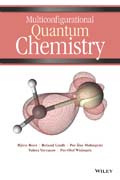
Multiconfigurational Quantum Chemistry
Roos, Björn O.
Lindh, Roland
Malmqvist, Per Åke
Veryazov, Valera
Widmark, Per–Olof
The first book to aid in the understanding of multiconfigurational quantum chemistry, Multiconfigurational Quantum Chemistry demystifies a subject that has historically been considered difficult to learn. Accessible to any reader with a background in quantum mechanics and quantum chemistry, the book contains illustrative examples showing how these methods can be used in various areas of chemistry, such as chemical reactions in ground and excited states, transition metal and other heavy element systems. The authors detail the drawbacks and limitations of DFT and coupled–cluster based methods and offer alternative, wavefunction–based methods more suitable for smaller molecules. INDICE: Preface xi .Conventions and Units xiii .1 Introduction 1 .1.1 References 4 .2 Mathematical Background 7 .2.1 Introduction 7 .2.2 Convenient Matrix Algebra 7 .2.3 Many–Electron Basis Functions 11 .2.4 Probability Basics 14 .2.5 Density Functions for Particles 16 .2.6 Wave Functions and Density Functions 17 .2.7 Density Matrices 18 .2.8 References 22 .3 Molecular Orbital Theory 23 .3.1 Atomic Orbitals 24 .3.1.1 The Hydrogen Atom 24 .3.1.2 The Helium Atom 26 .3.1.3 Many Electron Atoms 28 .3.2 Molecular Orbitals 29 .3.2.1 The Born Oppenheimer Approximation 29 .3.2.2 The LCAO Method 30 .3.2.3 The Helium Dimer 34 .3.2.4 The Lithium and Beryllium Dimers 35 .3.2.5 The B to Ne Dimers 35 .3.2.6 Heteronuclear Diatomic Molecules 37 .3.2.7 Polyatomic Molecules 39 .3.3 Further Reading 41 .4 Hartree Fock Theory 43 .4.1 The Hartree Fock Theory 44 .4.1.1 Approximating the Wave Function 44 .4.1.2 The Hartree Fock Equations 45 .4.2 Restrictions on The Hartree Fock Wave Function 49 .4.2.1 Spin Properties of Hartree Fock Wave Functions 50 .4.3 The Roothaan Hall Equations 53 .4.4 Practical Issues 55 .4.4.1 Dissociation of Hydrogen Molecule 55 .4.4.2 The Hartree–Fock Solution 56 .4.5 Further Reading 57 .4.6 References 58 .5 Relativistic Effects 59 .5.1 Relativistic Effects on Chemistry 59 .5.2 Relativistic Quantum Chemistry 62 .5.3 The Douglas Kroll Hess Transformation 64 .5.4 Further Reading 66 .5.5 References 66 .6 Basis Sets 69 .6.1 General Concepts 69 .6.2 Slater Type Orbitals, STOs 70 .6.3 Gaussian Type Orbitals, GTOs 71 .6.3.1 Shell Structure Organization 71 .6.3.2 Cartesian and Real Spherical Harmonics Angular Momentum Functions 72 .6.4 Constructing Basis Sets 72 .6.4.1 Obtaining Exponents 73 .6.4.2 Contraction Schemes 73 .6.4.3 Convergence in the Basis Set Size 77 .6.5 Selection of Basis Sets 79 .6.5.1 Effect of the Hamiltonian 79 .6.5.2 Core Correlation 80 .6.5.3 Other Issues 81 .6.6 References 81 .7 Second Quantization and Multiconfigurational Wave Functions 85 .7.1 Second Quantization 85 .7.2 Second Quantization Operators 86 .7.3 Spin and Spin–Free Formalisms 89 .7.4 Further Reading 90 .7.5 References 91 .8 Electron Correlation 93 .8.1 Dynamical and Nondynamical Correlation 93 .8.2 The Interelectron Cusp 94 .8.3 Broken Bonds. ( )2 ( )2 97 .8.4 Multiple Bonds, Aromatic Rings 99 .8.5 Other Correlation Issues 100 .8.6 Further Reading 102 .8.7 References 102 .9 Multiconfigurational SCF Theory 103 .9.1 Multiconfigurational SCF Theory 103 .9.1.1 The H2 Molecule 104 .9.1.2 Multiple Bonds 107 .9.1.3 Molecules with Competing Valence Structures 108 .9.1.4 Transition States on Energy Surfaces 109 .9.1.5 Other Cases of Near–Degeneracy Effects 110 .9.1.6 Static and Dynamic Correlation 111 .9.2 Determination of the MCSCF Wave Function 114 .9.2.1 Exponential Operators and Orbital Transformations 115 .9.2.2 Slater Determinants and Spin–Adapted State Functions 117 .9.2.3 The MCSCF Gradient and Hessian 119 .9.3 Complete and Restricted Active Spaces, the CASSCF and RASSCF Methods 121 .9.3.1 State Average MCSCF 125 .9.3.2 Novel MCSCF Methods 125 .9.4 Choosing the Active Space 126 .9.4.1 Atoms and Atomic Ions 126 .9.4.2 Molecules Built from Main Group Atoms 128 .9.5 References 130 .10 The RAS State–Interaction Method 131 .10.1 The Biorthogonal Transformation 131 .10.2 Common One–Electron Properties 133 .10.3 Wigner Eckart Coefficients for Spin Orbit Interaction 134 .10.4 Unconventional Usage of RASSI 135 .10.5 Further Reading 136 .10.6 References 136 .11 The Multireference CI Method 137 .11.1 Single–Reference CI. Nonextensivity 137 .11.2 Multireference CI 139 .11.3 Further Reading 140 .11.4 References 140 .12 Multiconfigurational Reference Perturbation Theory 143 .12.1 CASPT2 theory 143 .12.1.1 Introduction 143 .12.1.2 Quasi–Degenerate Rayleigh Schrödinger Perturbation Theory 144 .12.1.3 The First–Order Interacting Space 145 .12.1.4 Multiconfigurational Root States 146 .12.1.5 The CASPT2 Equations 148 .12.1.6 IPEA, RASPT2, and MS–CASPT2 154 .12.2 References 155 .13 CASPT2/CASSCF Applications 157 .13.1 Orbital Representations 158 .13.1.1 Starting Orbitals: Atomic Orbitals 162 .13.1.2 Starting Orbitals: Molecular Orbitals 164 .13.2 Specific Applications 167 .13.2.1 Ground State Reactions 167 .13.2.2 Excited States Vertical Excitation Energies 171 .13.2.3 Photochemistry and Photophysics 184 .13.2.4 Transition Metal Chemistry 194 .13.2.5 Spin–Orbit Chemistry 202 .13.2.6 Lanthanide Chemistry 207 .13.2.7 Actinide Chemistry 209 .13.2.8 RASSCF/RASPT2 Applications 212 .13.3 References 216 .Summary and Conclusion 219 .Index 221
- ISBN: 978-0-470-63346-5
- Editorial: Wiley–Blackwell
- Encuadernacion: Cartoné
- Páginas: 240
- Fecha Publicación: 27/09/2016
- Nº Volúmenes: 1
- Idioma: Inglés
